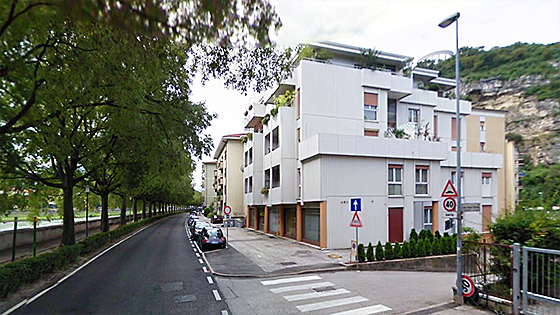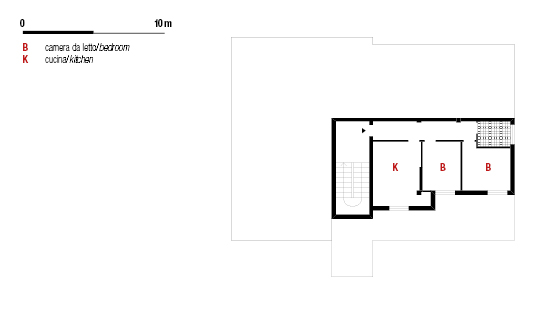2014/10/19
Trento – casa condivisa da ricercatori fuorisede/a researchers’ cohousing
Stazionamento di cervelli
Cristina Mattiucci
Trento è sede di un’università dal 1962. Il territorio ospita oltre venti centri di ricerca pubblici e privati, per un’attività che attrae numerosi finanziamenti internazionali e muta profondamente gli equilibri economici locali, costituendo oggi una significativa sede di impiego.
Di pari passo con il florilegio delle formule contrattuali che le riforme universitarie hanno previsto, l’attivazione di contratti di ricerca con diversi tempi e modalità di realizzazione hanno reso la città sede di un peculiare flusso di abitanti: una enclave di cervelli in stazionamento, di provenienza nazionale ed internazionale, che non possono essere collocati né tra i commuters né tra i city-users, eppure vi lavorano e ne usano i servizi per un tempo definito e determinato, ma così a lunga durata da poter essere considerato stanziale.
Nel 2011 è stata registrata la presenza di oltre 2.500 ricercatori: a Trento il rapporto tra numero di abitanti e numero di ricercatori è tra i più alti d’Italia.
Attraverso un sottile scardinamento delle abitudini tradizionali, questa presenza ha profondamente mutato non solo il profilo della popolazione, gli usi dello spazio pubblico, gli orari dei negozi, la rarefazione del dialetto negli esercizi commerciali, le origini miste delle coppie in giro, ma anche il mercato delle case in affitto, ovvero i soggetti destinatari, la domanda e dunque i prezzi e l’offerta abitativa stessa.
Mentre nel 2007 veniva collocato in città “The Family Monument”, il monumento di Gillian Wearing dedicato alla famiglia trentina “tipo” – mamma, papà, due figli maschio & femmina, con cane – l’evidenza empirica di altre, nuove forme di coabitazione e dunque di familiarità intorno al focolare domestico era così evidente da rendere quell’immagine molto controversa. Una formula di coabitazione decisamente peculiare è quella dei ricercatori e delle ricercatrici che spendono a Trento un tempo consistente della loro esistenza e cercano nella condivisione di una casa la possibilità di economizzare sull’affitto e di realizzare una socialità oltre il lavoro.
Molti abitano un patrimonio di (ex) edilizia pubblica e/o sovvenzionata che offre in città abitazioni di discreta qualità edilizia, con stanze abbastanza grandi da potervi sistemare con un certo confort il necessario per sei mesi-un anno di permanenza. Le storie di coabitazione sono molte e nascono spesso sulla condizione precaria dei contratti che legano alla città, sebbene la precarietà stessa in qualche modo poi si “calcifichi” proprio nello spazio della casa, dove uomini e donne con un’età che va dai 30 ai 40 anni si incontrano al mattino ed alla sera, e talvolta nei weekend.
La casa di Via Caio Valerio Mariano ne è un esempio. Al terzo piano di una palazzina costruita nel 1971, l’alloggio si sviluppa lungo l’asse di un corridoio che distribuisce, in sequenza dall’ingresso, un soggiorno con cucina e due camere da letto, con bagno in fondo. Oggi quelle due stanze, destinate nel progetto originario ad un letto singolo, l’una, ed al matrimoniale dei genitori, l’altra, sono occupate da un più pratico letto ad una piazza e mezza ed ospitano persone che lavorano altrove e dunque non necessitano di uno spazio di studio specifico, condividendo la cucina/soggiorno e nella bella stagione il terrazzo.
L’appartamento è abitato da ricercatori e ricercatrici dal 2008. Vi hanno vissuto Roberta e Chiara, Roberta e Michela, Michela e Fabio, Michela ed Elisa, Elisa e Daniele, e oggi è la casa di Elisa e Chrysa(1). Lo sarà ancora per poco. Chrysa medita di ricongiungersi ad un compagno/collega che è di stanza a Mosca e a dicembre Elisa finirà la borsa di dottorato e medita di trasferirsi a Berlino. Hanno già messo voce in giro per passarla di mano.
(1) Provenienza, contratto di lavoro e tempo di permanenza, nell’ordine: Napoli e Castel Franco Veneto, dottorande, 3 anni; Napoli e Cava de’ Tirreni (Sa), ricercatrice e dottoranda, 1 anno; Cava de’ Tirreni (Sa) e Roma, ricercatrice e informatico, 6 mesi; Cava de’ Tirreni (Sa) e Montagnaga di Pinè (Tn), ricercatrice e dottoranda, 1 anno; Montagnaga di Pinè (Tn) e Trento, ricercatrice e libero professionista, 6 mesi; Montagnaga di Pinè e Atene, dottoranda e post-doc, 1 anno, in corso.
Brain parking
Cristina Mattiucci
Trento has been hosting a university since 1962. In the municipal territory there are more than twenty public or private research centers. These generate an activity that attracts substantial international funding and has profoundly changed the local economy, constituting a real enterprise and job centre.
Hand in hand with the several contractual formulas that university has provided, the research contracts, with their different terms and conditions, have produced a peculiar flow of inhabitants. These “brains in parking” can be considered neither as commuters nor as city-users. They work in Trento and use the services for a defined time, yet so durable that it can almost be considered as permanent.
In 2011 the presence of more than 2,500 researchers was recorded: in Trento, the ratio between the number of inhabitants and the number of researchers is among the highest in Italy.
Through a subtle deconstruction of the traditional customs, this presence has profoundly changed not only the population features, the uses of public space, the opening times of shops, the (decreasing) use of the dialect in commercial places, the mixed origins of the couples, but also the housing rental market, the identity of the owners and the tenants, and therefore the prices and the characters of housing itself.
While in 2007 “The Family Monument” by Gillian Wearing – a monument dedicated to the “typical” family of Trento (mom, dad, two kids male & female, with a dog) – was placed in the city, the empirical evidence of other, new forms of cohabitation and therefore familiarities around the home hearth was so evident as to render that image very controversial. A highly peculiar formula of coexistence involves researchers who spend in Trento a significant part of their age and find in house-sharing a possibility to reduce the rent and provide a social life beyond the work.
Many of them live in (previous) public and/or subsidized houses, which offer, in decent-quality buildings, rooms large enough to host with some comfort the goods needed for six months to one year of residence. The stories of cohabitation are many and they are often based on the precarious condition of the contracts that bind the researchers to the city. The precariousness itself “calcifies” in some ways in the house, where men and women – with an age range from 30 to 40 years – meet each other mostly in the early morning and in the evening, occasionally also during the weekends.
The house in Via Caio Valerio Mariano is an example. It is placed on the third floor of a building built in 1971 and projected along the axis of a corridor that distributes, in sequence from the entrance, a living room with kitchen and two bedrooms, with the bathroom down it. Today, those two bedrooms - that in the original project were designed one for a single bed, the other for the parents double bed - are both occupied by a queen-size bed and host people who work elsewhere and so who do not need an area to study, sharing the kitchen / living room and the terrace, in the summer.
The apartment has been inhabited by scientists and researchers since 2008. Roberta and Chiara, Roberta and Michela, Michela and Fabio, Michela and Elisa, Elisa and Daniele lived here, and today it is Elisa and Chrysa’s home(1).
It will be not for long. Chrysa meditates to rejoin her partner and colleague who is now in Moscow, and Elisa will end in December her PhD scholarships and meditates to move to Berlin. They have already spread informations around to pass it from hand.
(1) Origin, job and permanence time, in order: Naples and Castel Franco Veneto (Ve), PhD students, 3 years; Naples and Cava de 'Tirreni (Sa), researcher and PhD student, 1 year; Cava de 'Tirreni (Sa) and Rome, researcher and computer scientist, 6 months; Cava de 'Tirreni (Sa) and Montagnaga di Pine (Tn), researcher and PhD student, 1 year; Montagnaga di Pine (Tn) and Trento, PhD student and freelancer, 6 months; Montagnaga di Pine and Athens, PhD student and post-doc researcher, 1 year, ongoing.
Guarda l’intervista in HD su Youtube/Watch the interview in HD on Youtube
№ 11/21
№ 1/1
Next project: → Napoli – un parco residenziale/a residential park
Previous project: ← Bitti – una casa in autocostruzione/a self-built house

